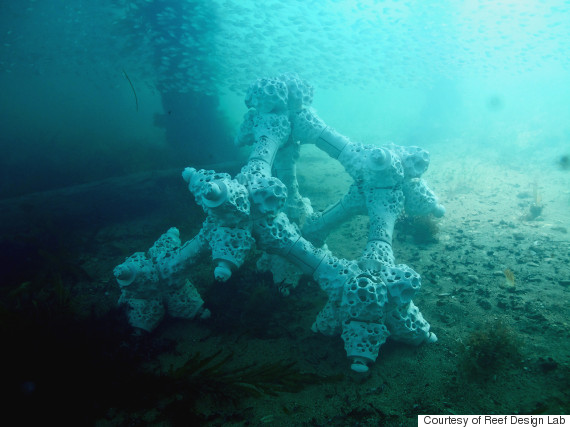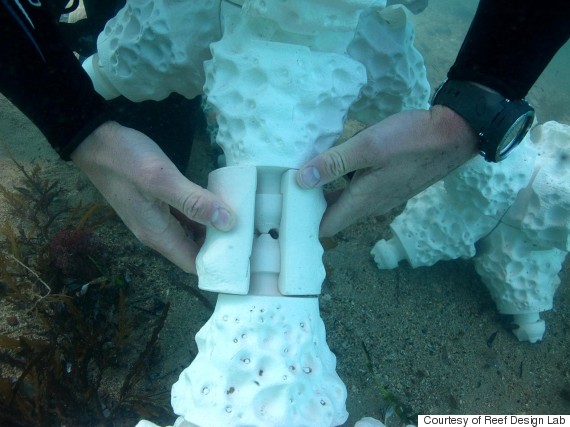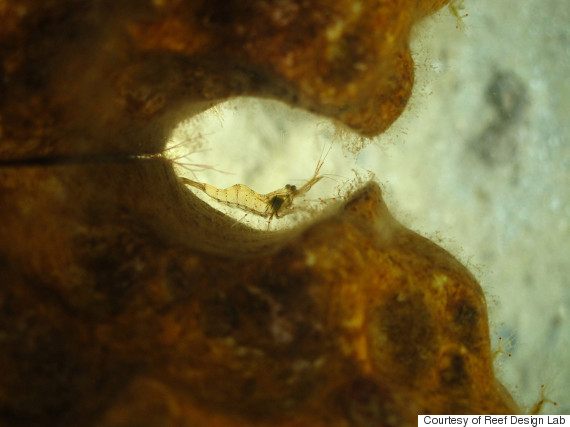
An Australian designer is going to allow plenty of sea creatures around the world to “just keep swimming.”
Alex Goad, a designer in Melbourne, Australia, has developed a new artificial structure to help rebuild coral reef habitats that have been damaged or destroyed. Called MARS (Modular Artificial Reef Structure), the ceramic, Lego-like modules will “act as building blocks to help repopulate corals and fish stocks,” Goad wrote in his abstract for MARS.

After testing concrete, metals and ceramics, Goad learned that because ceramics and coral have a similar chemical composition -- both contain calcium carbonate -- organisms are more apt to colonize on ceramic surfaces than on other artificial materials, and therefore it was the best choice for man-made reefs, Goad told The Huffington Post in an email.
"Ceramics has been used in the aquarium market for the last 50 years and is the go-to material for transplanting sensitive coral," he said.
The ceramic slip Goad uses to build MARS is food grade ceramic and does not contain lead or other toxins present in some mixtures of ceramic. So long as the ceramic is fired to the correct temperature, "the material is completely inert and in a solid state," he says, meaning that even if there were toxins present they would not be available for uptake by marine organisms.
The product aims to be accessible and adaptable to all types of communities suffering reef damage. MARS will also be affordable and easy to build on site, Australia Geographic reports.
“[It] is designed to be implemented by hand to avoid the costs of barges and cranes required for conventional artificial reefs products,” Goad told HuffPost. “Many communities that have experienced reef decline are often not able or willing to invest in restoring their damaged reef, which is why we want the product to be as affordable as possible.”

MARS intends not to just replace reefs that have been destroyed, but naturally speed up the regrowth of ecosystems that have been hurt by damaged reefs. Natural corals have growth rates of 0.3 to 10 centimeters per year, depending on type, according to the National Oceanic and Atmospheric Administration. But, as Goad explained to London-based design magazine Dezeen, "What may have taken 100 years to restore naturally can be reduced to an estimated eight to 15 years using the MARS system."
The artificial structures mimic the size and shape of natural coral -- they are porous, with indentations and crevices that allow plants to grow and organisms to colonize while being protected. This innovation allows populations that have suffered due to reef decline to thrive and repopulate without the threat of predators.
However, the development of artificial reefs isn't without controversy: Some people believe coral reefs should be left to nature to restore and and rebuild. Others argue that artificial reefs can disrupt the natural populating of species and may be used to overpopulate marine life for harvesting. "Some biologists worry that artificial reefs simply attract fish from natural reefs and may become killing zones for certain sought-after fish," National Geographic reported in February 2011. Artificial reefs that are poorly designed and planned can damage ecosystems, according to NOAA.
"Many people still do not agree with the use of artificial reefs for restoration believing that reef systems should be left alone to restore themselves. In many cases this is an acceptable practice however when the rate of destruction far exceeds the rate of natural coral growth then we must intervene," Goad said.

MARS is currently being tested in Port Phillip Bay, in Melbourne, where many shellfish reefs have been damaged. Though still in the development stage, MARS is already proving successful after just a few months underwater. Goad has documented shellfish colonization and a variety of fish hiding in the designed protective spaces of the units, he told HuffPost. Small seaweeds, sponges and other organisms and vegetation are also naturally growing amongst the modules.

The concept, which began as Goad’s final honors graduate project in industrial design at Melbourne’s Monash University, in 2013, won the graduate prize for Best Product Design, as well as the Hills Young Australian Design Award for Sustainability and the James Dyson Award Australia.
Goad is hoping to have a final product completed by the end of 2015. He is developing the project under Reef Design Lab, a Melbourne-based not-for-profit studio he founded with artificial reef expert and scientist David Lennon. When it is complete, they hope to sell MARS to various reef restoration organizations and communities that have experienced reef decline.


